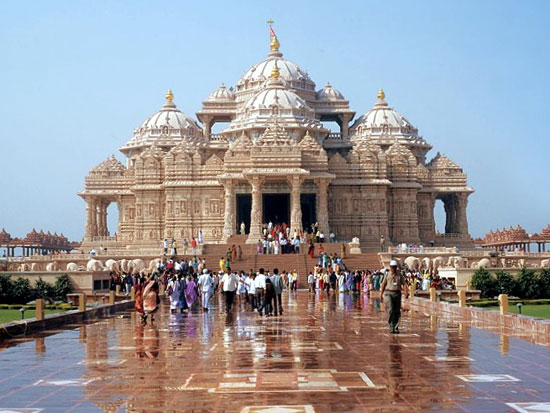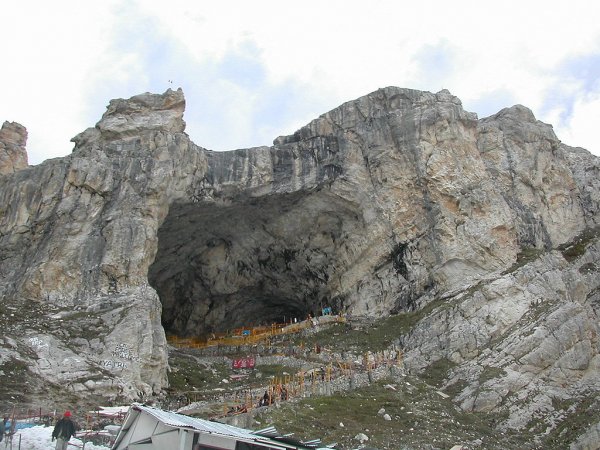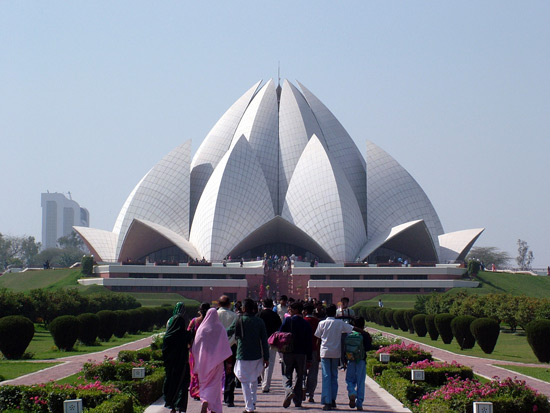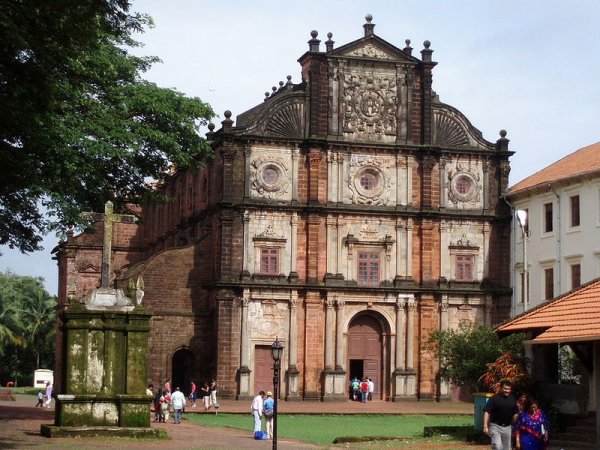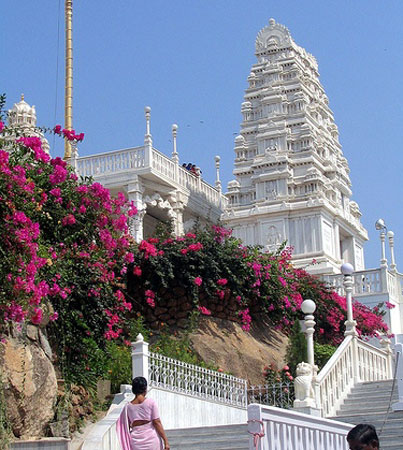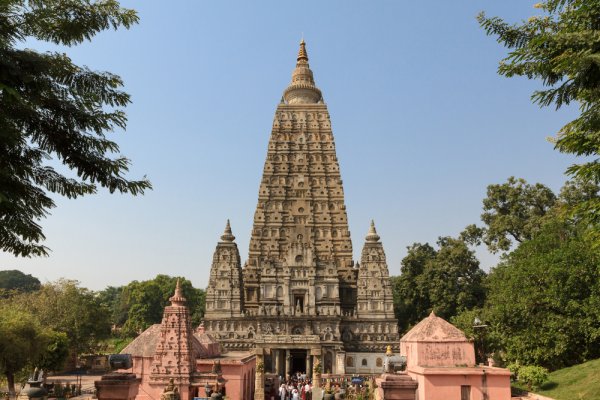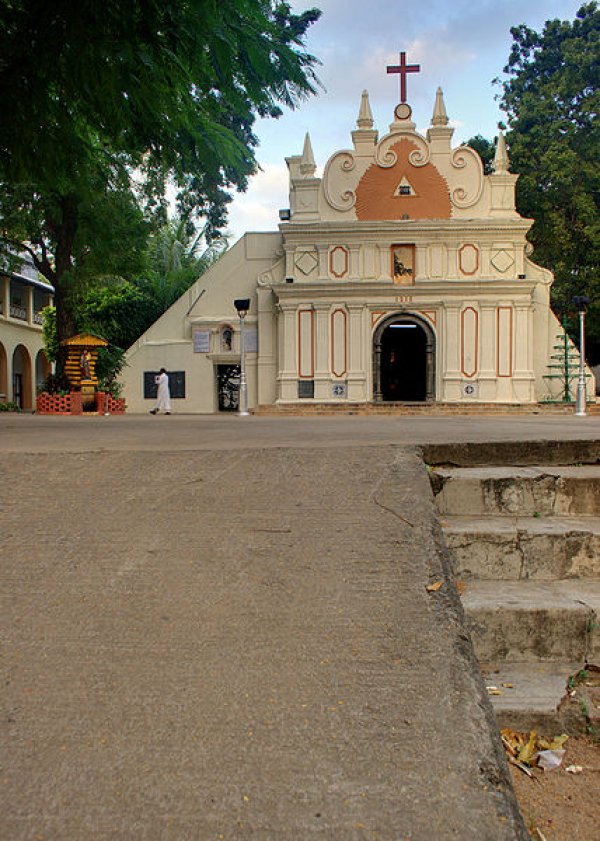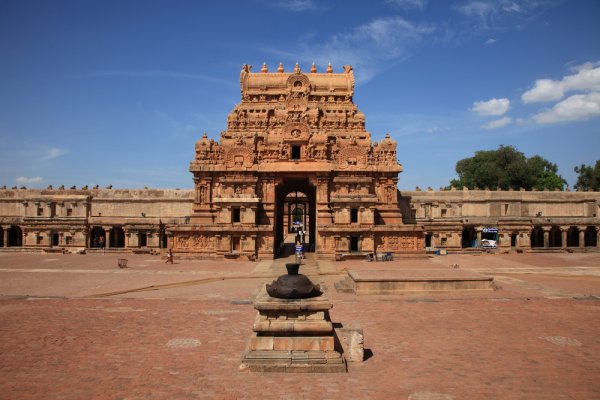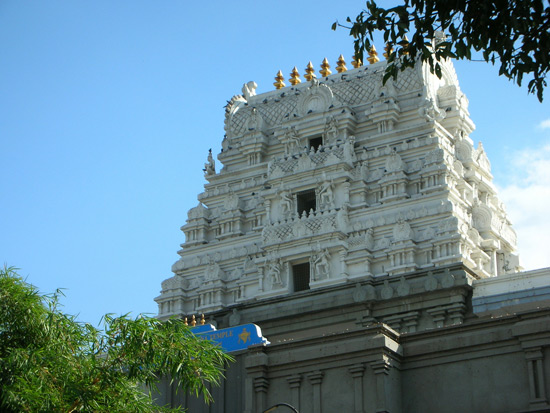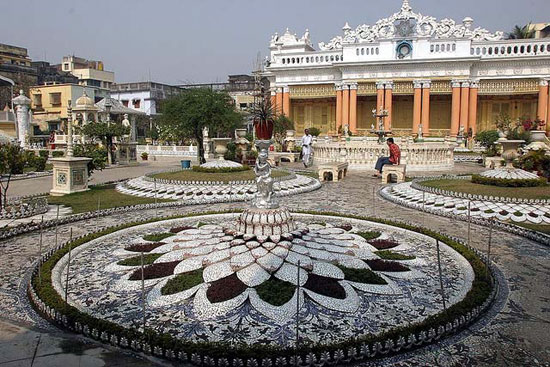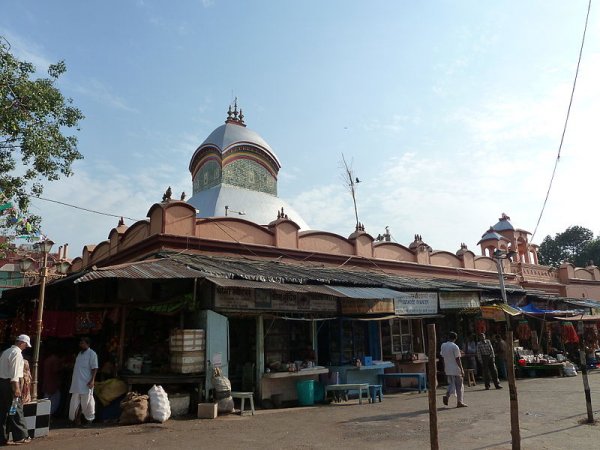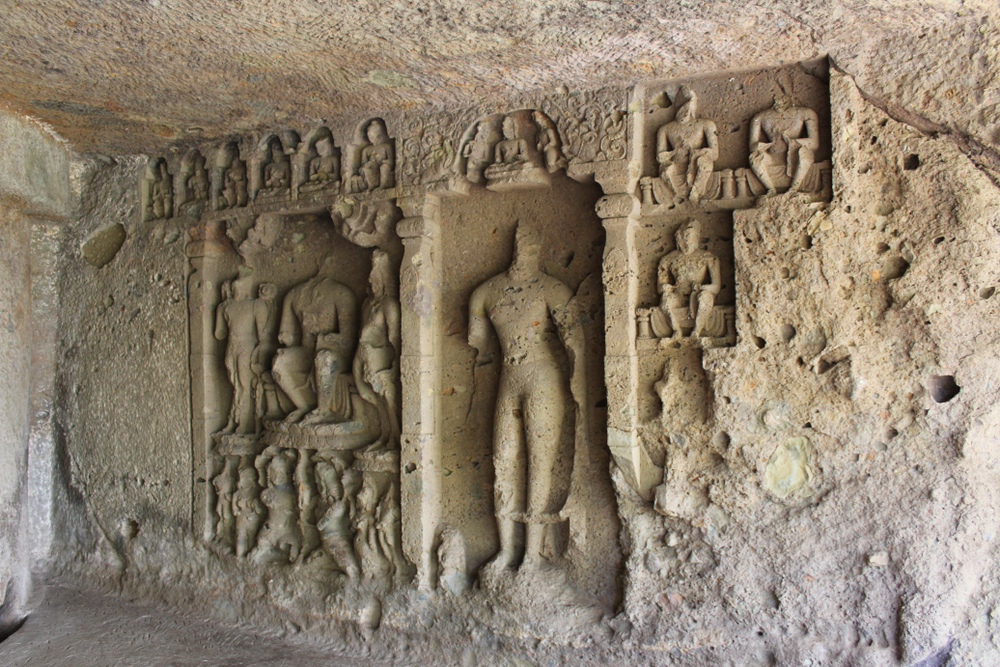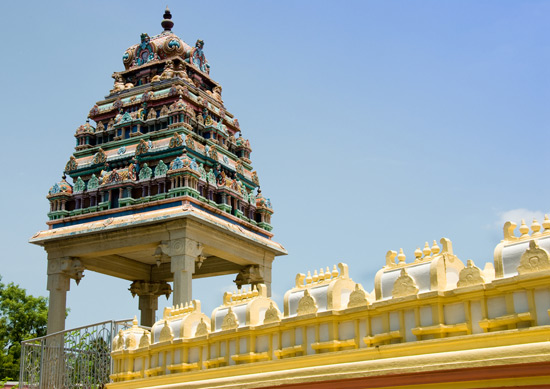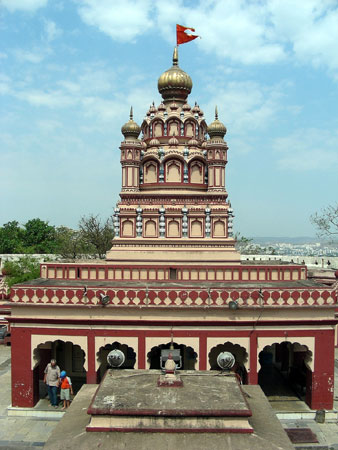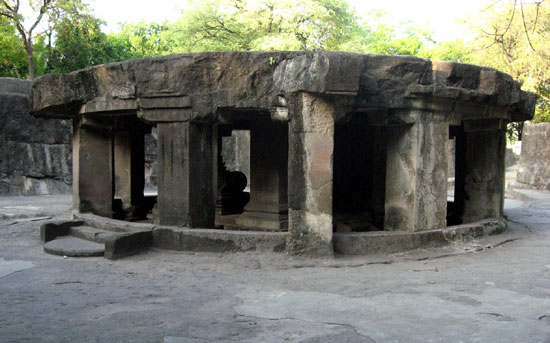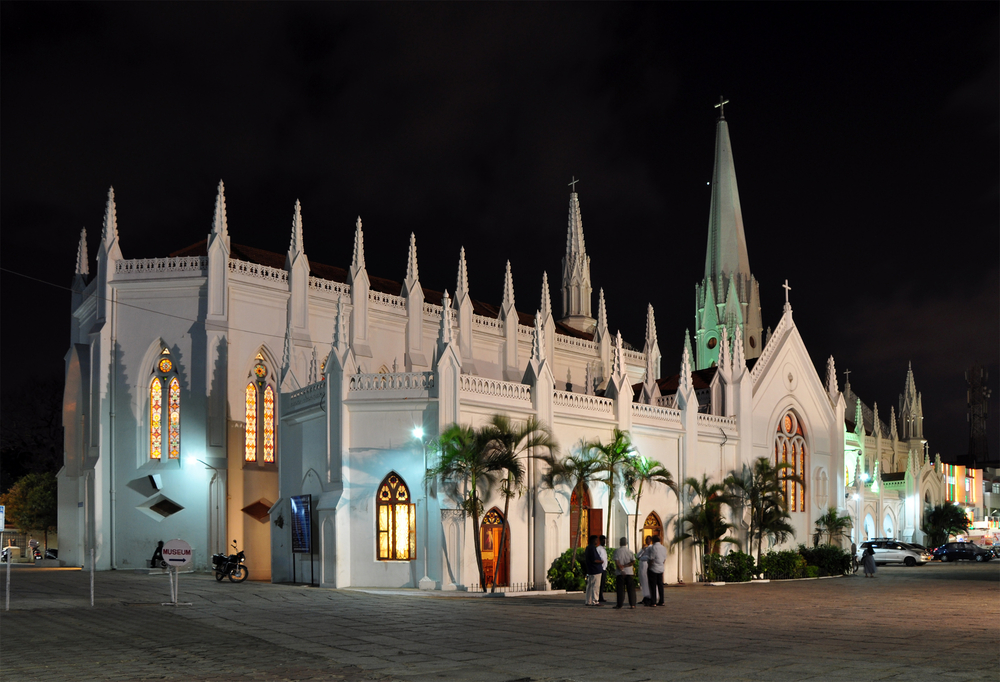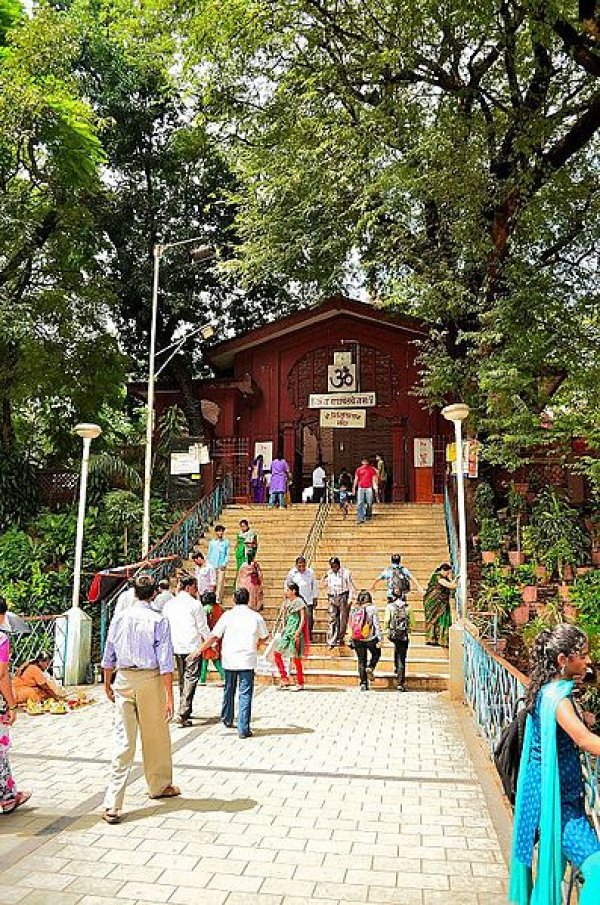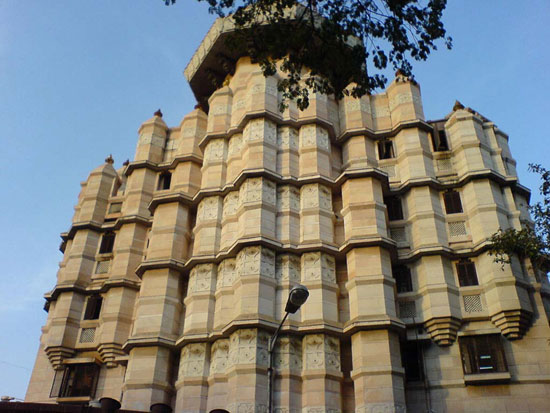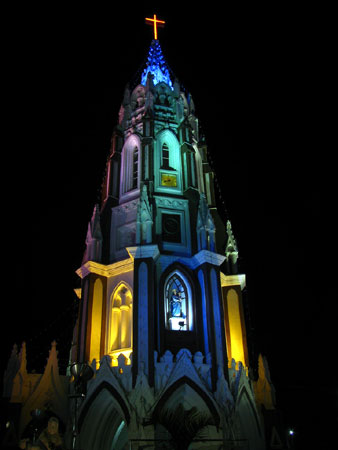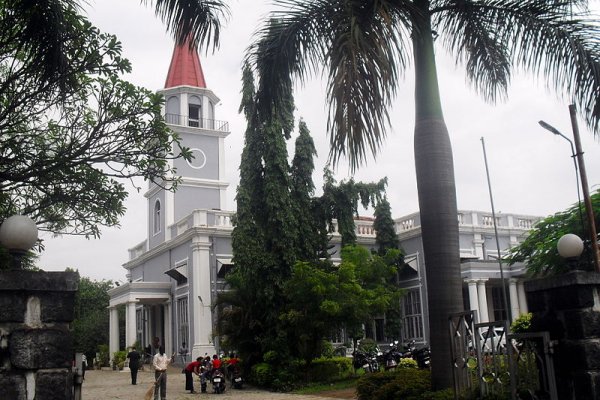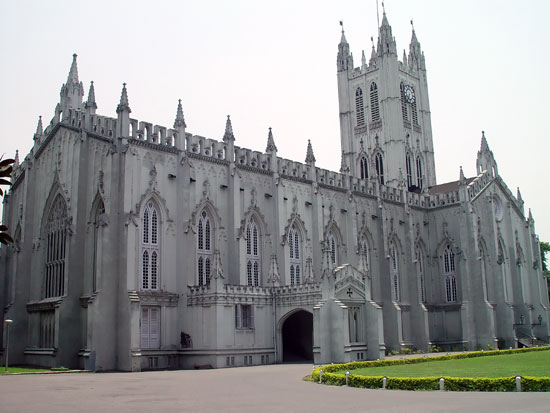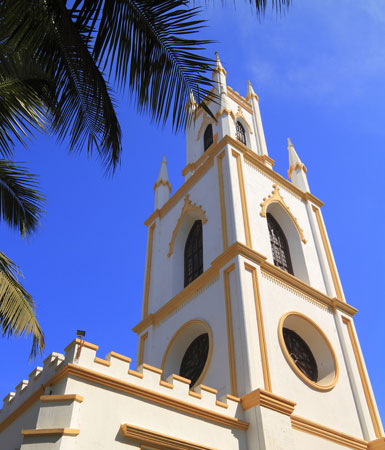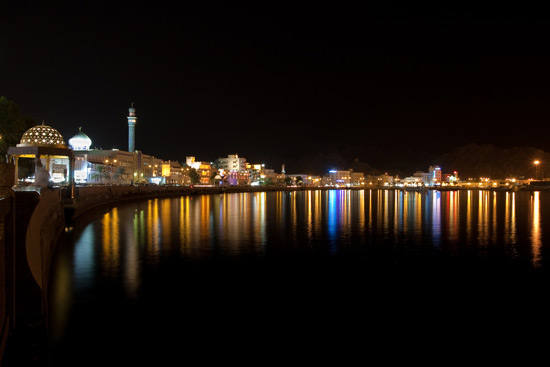Points of Interest
Akshardham
National Highway 24, Near Noida Mor
New Delhi, India
Although many Delhi temples date back to the Moghuls, perhaps the most magnificent is a 21st-century construction. Akshardham, a spectacular example of traditional Indian temple architecture, was completed in 2005. Featuring 6,000 tons of pink sandstone from Rajasthan (along with a substantial amount of Italian Carrara marble), it was built by around 10,000 workers, 30 percent of whom were volunteers. Though the original cutting of the stone was done using machines, 7,000 carvers executed all the intricate details on the walls of the main monument, making this place of worship a blend of modern techniques and ancient skills. Spread out across its 40-hectare (100-acre) site on the east bank of the Yamuna River are a musical fountain, a boat ride, a stepwell, and 148 life-size stone elephants. On the temple's gates are sculpted 869 peacocks, India's national bird.
Amarnath
About 141 kilometers east of Srinagar Forest Block
Jammu and Kashmir, India
Situated at an altitude of about 3,888 meters (12,831 feet) inside a huge cave, the cave shrine of Amarnath, according to ancient Hindu mythology, is where Lord Shiva told his consort Parvati about the secret of life and eternity. It now comprises the natural cylindrical ice Shivalingam (symbol of worship of Lord Shiva), which can grow up to 3.7 meters (12 feet) tall from May to August but gradually thaws thereafter due to the warm weather, and other lingams representing Parvati and Ganesha (son of Shiva). This shrine is over 5,000 years old and a highly important Hindu pilgrimage destination, attracting nearly 400,000 devotees in July and August during the 45-day annual pilgrimage season called Amarnath Yatra.
Ashtalakshmi Temple
Beach Road
Odaimanagar Besant Nagar, Chennai, India
The only temple in India featuring the eight manifestations of the goddess Mahalakshmi, this relatively new structure, built in 1976, nonetheless features various characteristics of traditional Dravidian temple architecture. The temple complex consists of a series of five tiers distinguished by intricate stone work painted in a multitude of colors. The second tier holds images of the principal deities, Mahalakshmi and Mahavishnu.
Badshahi Royal Ashurkhana
Mahboob Shahi Road
Hyderabad, India
The two key features of this traditional Muslim house of mourning are fine timber columns and intricate hexagonal mosaics, which surpass any mere description. These were added in the 18th century, long after the edifice was built in 1594 by the Nizam of the time, Muhammad Quli Qutub. It's quite remarkable how the enamel and paint has remained so lustrous and shiny after all these years. Ashurkhanas are singularly Shia Muslim institutions that assume a great deal of importance during the remembrance month of Muharram, particularly the Day of Ashura, which commemorates the martyrdom of Husayn ibn Ali, grandson of the Prophet Muhammad, the event that cemented the split between Shia and Sunni sects. This Ashurkhana is administrated by the State Department of Archeology and Museums.
Bahá'í Lotus Temple
Lotus Temple Road
Kalkaji, New Delhi, India
Commissioned to design a Bahá'í temple in South Delhi, architect Fariborz Sahba conceived a totally original version of the Bahá'í faith's traditional nine-sided temple. His construction, composed of 27 concrete petals clad in white marble, looks like an unfurling flower. Bahá'í is a well-established religion in India, with more than two million followers. Sahba, an architect based in Canada but born in Iran, traveled across the country studying traditional temple designs. His Lotus Temple, as it is popularly known, offered unique challenges to the construction team. As temperatures in Delhi rose, the builders worried that the concrete would not set-they solved that problem by adding ice to the cement. The resulting building, impressive from the outside, is equally striking inside, with worshippers practicing in total silence. Since its completion in 1986, it has attracted more than 50 million visitors.
Barabazaar
North of BBD Bagh
Kolkata, India
Barabazaar is a loose conglomeration of holy sites that should be experienced as one single attraction. The long-time gathering place of Kolkata's small Jewish community, Moghan David Synagogue is remarkable for its whitewashed façade and high-reaching spire. The twin turrets of BethEl Synagogue are also worth a wander around. Nearby is Nakhoda Mosque, an early-20th-century structure of numerous small towers and domes. Reputed to be the oldest Christian church in West Bengal, the Armenian Church is open between 9am and 11am every Sunday. The overtly Iberian-looking Holy Rosary Cathedral is probably the most significant place of Catholic worship in the city, dating back to the days when the Portuguese still had some influence in India.
Basilica of Bom Jesus
Off of Old Goa Road and Gandhi Circle North
Old Goa, Goa 403402, India
Built around the 17th century as the country's first Minor Basilica, the Basilica of Bom Jesus entombs the mortal body of St. Francis Xavier, patron saint of Goa, in an airtight glass coffin placed inside a silver casket. The saint's body is best known for its miraculous healing powers, which attract large numbers of devotees from all over the world. In addition, the basilica is richly adorned with white marble, granite, wood, precious stones, elaborate glided altars, ancient murals, frescoes, inlay work, several paintings depicting the life of St. Francis Xavier, and an art gallery.
Birla Mandir
Near Hussain Sagar
Hyderabad, India
A relatively recent gem near the Husain Sagar lake, this temple is well known around the Hindu world for its ornate ceiling carvings of numerous deities, influenced by both North and South Indian artistic styles. The original craftsmen were supposedly descended from those who designed the Taj Mahal. The mandir was erected in 1976 as part of a nationwide temple-building project financed by the wealthy Birla dynasty, who were also behind similar projects in New Delhi, Kolkata, and Chennai. The view of the streets and lake from the temple at night is wondrous and has been compared to looking at a pearl necklace, which is very apt for the City of Pearls.
Bodh Gaya
Off of Domuhan-Bodhgaya Road
South of Gaya Gaya District
Bodhgaya, Bihar 824231, India
The Emperor Ashoka built the famous Mahabodhi Temple with its Vajrasana (Diamond Throne) at Bodh Gaya in the 3rd century BCE to mark the site where Gautama Buddha attained enlightenment about 250 years before. Behind the temple is a sacred Bodhi Tree, a fig tree believed to be a descendant of the original Bodhi tree under which the Buddha sat. Bodh Gaya now ranks among one of the most important Buddhist pilgrimage sites and is visited by Buddhists from around the globe. Although the original temple no longer stands, the present temple dates back to the 5th or 6th century.
Chatushringi Temple
Chaturshringi Mandir Senapati Bapat Road
Camp District, Pune, India
Legend has it that this grandiose Hindu temple was built by a wandering merchant who saw a vision of the goddess Chatushringi in his dreams. It is almost 100 feet tall, and its curved domes and red pillars stand resplendent atop 100 steps on a hillside in the Camp district. During the Navrati Festival in October and November of each year, thousands of pilgrims from across Western India flock here to pay their respects to the ancient idol of the goddess whose origins no one can be sure about.
Chilkur Balaji Temple
Banks of Osman Sagar Lake
Chilkur, Hyderabad, India
Between 750,000 and a million of the Hindu faithful visit this major pilgrim destination each year to pay their respects to the statue of Sri Venkatswera Swamy that stands proud between the goddesses Bhudevi and Sridevi. Look closely and you'll see what appears to be an injury on Lord Swami's chest. This was supposedly sustained while the deity was trying to dig up a precious idol buried under the temple. Oddly enough, he is also known as the "visa god" by Hyderabadi students, who come and pray to him after making visa applications to study in the United States. Entrance is free and visitors are welcome daily between 6am and 8pm
Church of Our Lady of Light
Luz Church Road
Mylapore, Chennai, India
Popularly known as Luz Church or Kaatu Kovil (church in the forest), the structure was built by Franciscan missionaries from Portugal in 1516 and is believed to be the oldest church in Chennai. Noted for for its European-style architecture, it features Gothic arches and Baroque ornamentation.
Great Living Chola Temples
Thanjavur and Ariyalur Districts
Thanjavur, Darasuram, and Gangaikonda Cholapuram
Tamil Nadu, India
The Great Living Chola Temples comprise three granite-stone temples: the Brihadeeswara Temple at Thanjavur, Gangaikonda Temple at Gangaikonda Cholapuram, and Airavatesvara Temple at Darasuram. Featuring Lord Shiva as the central deity, these are classic examples of Tamil Dravidian temple art and architecture. The 11th-century Brihadeeswara Temple contains the Periya Koyil (Big Temple) with an 8.7-meter-tall (28.7-foot-tall) Shivalingam (the world's largest), a 70-meter-tall (231-foot-tall) pyramidal vimana (tower), various sculptures, murals, and Thanjavur-style frescoes. The 11th-century Gangaikonda Temple comprises a 55-meter (181-foot) vimana, six pairs of dvarapalas (entrance guards), beautiful bronzes, intricate carvings, and many statues. The 12th-century Airavatesvara, built by Rajaraja II, features a 24-meter (79-foot) vimana and a stone image of Lord Shiva.
Haji Ali Dargah
Mumbai, India
Haji Ali Dargah is a stunning Indo-Islamic shrine built in 1431 in memory of a wealthy merchant who lost his life on the pilgrimage from India to Mecca. The shrine is situated on an island 500 meters off the west coast of Mumbai, and at high tide, when the sea overruns the walkway leading to it, Haji Ali can appear to be floating in Worli Bay—a magical sight if ever there was one. After traversing the walkway, touched by the cool sea breeze, you'll enter a tomb that is covered with a brocaded sheet hanging from a silver frame. The marble, mirrored pillars that detail the 99 names of Allah are the major architectural highlight here. Sufi qawwali singers are known to perform at this popular pilgrimage site, particularly on Fridays.
ISKCON Temple
1st Block, Harekrishna Hill Chord Road
Rajaji Nagar, Bangalore, India
The spiritual headquarters of the International Society of Krishna Consciousness (ISKCON), this temple is an ornate fusion of ultra-contemporary and vintage Indian architectural styles. It's also very big, covering a space of nearly three hectares (7 acres) and incorporating Sri Radha Krishna Madir, a beautiful shrine to the gods Krishna and Radha, which also happens to be a souvenir shop. The complex was designed by Mumbai civil engineer Sri Madhu Pandit Dasa and built in 1988 on rocky wasteland. Thousands of devoted Hare Krishnas attend the annual Krishna and Balarama Rath Yatra festivities held here. Guided tours of the temple and lectures on Hare Krishna theology are offered on a daily basis.
Jain Temples
Badridas Temple Street
Kolkata, India
Not just one, but a complex of three remarkable Jain temples is located in North Kolkata. The intricately decorated, wave-roofed exterior is one of a kind: arguably as iconic as the Taj Mahal or the Gateway of India. Over 2,000 years old, the Jain religion's key tenets are pacifism, spiritual liberation through faith and good conduct, and intellectual scholarship. Thus these temples contain grandiose busts of Mahavira, the sage who is revered as having developed the basic principles of the religion. Mirror-clad pillars and stained-glass windows in the main hallway create a thrilling effect. A stroll in the garden among the glass-cube mosaics is also highly recommended.
Jama Masjid
Off Netaji Subhash Marg and Meena Bazar
New Delhi, India
Constructed during 1644–1658 by the Mughal Emperor Shah Jahan, Jama Masjid is one of India's largest and best-known mosques. The mosque, known fully as the Masjid-i Jahān-Numā, is a blend of Hindu and Muslim architectural styles and has a capacity for over 25,000 worshippers. The main features include the high marble pulpit that is visible from all around, the profusion of alternate vertical stripes of red sandstone and white marble, three white marble domes with inscriptions in black marble and gold on its uppermost parts, three imposing gateways with three flights of steps from the east, north, and south, and a cupboard near the north gateway containing relics of Prophet Muhammad. Several arched entrances, small domes, minarets, and pillars flank the mosque.
Kali Temple
Kalighat
Kolkata, India
With its vast icon of the goddess Kali, replete with golden tongue and bulging eyes, it's no surprise that this temple is the holiest in Bengali Hinduism. Although there are references to the temple in Bengali literature of the 1400s, its current form evolved out of a modest hut erected just 200 years ago. Sloping verandas, sacrificial altars, sacred wells, and a bell pavilion all add to the mystical atmosphere. Rarely is the Kali Temple a quiet place of contemplation though, for tourists, priests, guides, and pilgrims dominate the premises throughout the day. Thus in many ways the temple merges seamlessly with the cramped market stalls encircling it.
Kapaleeshwarar Temple
Corner of N Mada Street and Mudaga Kanni Amman Koll Street
Mylapore, Chennai, India
Built by the Pallava kings in the 7th century, this incredibly ornate, pyramid-shaped temple is presided over by Kapaleeshwarar, a form of the Hindu god Shiva. But it also includes shrines dedicated to other Hindu gods, including Ganesh, Muruga and Shiva's wife Parvati. It's located a few blocks from the Thirumayilai rail station.
Konark Sun Temple
Off of Konark Road/203 North of Puri Konark
Odisha 752111, India
Constructed in the 13th century in a typical Kalinga architectural style, the Sun Temple is a colossal sculpture of the chariot of Surya, the sun god, with 24 elaborately-carved wheels pulled by seven horses, a pyramidal roof, and two lions and a flight of steps at the main entrance. This sandstone structure is famous for its profusion of intricate sculptural works, including three images of Surya positioned to capture the sun's rays at dawn, noon, and dusk. Other sculptures represent celestial beings and humans in scenes of courtly life, various erotic positions, and thousands of images of mythological creatures, birds, and animals. The temple also hosts the Konark Dance Festival each year.
Mahakali Caves
Mahakali Caves Road
Andheri East, Mumbai, India
On the outskirts of Mumbai, ancient caves carved from black basalt rock were once home to Buddhist monks of the ancient Ashoka Empire. Believed to have been carved between the 1st and 6th centuries, a total of 19 caves and several cisterns were where monks lived and meditated. The chaitya is the site’s main Buddhist shrine and prayer hall, adorned with stupas and statues. Some walls feature carvings of figures and scriptures written in Pali, a language older than Sanskrit. The modern name, Mahakali, is a misnomer referring to the Hindu goddess Kali for which there is a nearby temple.
Mecca Masjid
Charminar
Hyderabad, India
One of India's oldest and grandest mosques, Mecca Masjid was constructed in 1694 by 8,000 laborers under the command of the fifth Qutub sultan. Its characteristic triple arches were carved from one huge chunk of granite, and the result is impressive. Clay was supposedly imported from Mecca for the addition of the brick pillars that stand out for miles. To give you an idea of the scale of the mosque, the central hall is more than 20 meters (75 feet) high and the capacity is for more than 10,000 devotees at any one time. In 2007, tragedy struck in the form of a terrorist bomb that murdered at least 13 during Friday prayers. Thankfully, the site has been rebuilt and is once again proudly showing off its treasures to all comers.
Moula Ali Dargah
Moula Ali
Hyderabad, India
The Moula Ali suburb of Hyderabad is one of its oldest, boasting Iron Age burial sites galore. Amid these is a remarkable 300-year-old mosque characterized by a sweat-inducing 400-stair climb to its topmost minaret. The building memorializes Hazrat Ali, the son-in-law of the Prophet Muhammad. There used to be a nqqar khana (venue for playing ceremonial drums) and baradari (pavilion) attached to Moula Ali Dargah, but these have long since disappeared. For good reason the State of Andhra Pradesh Heritage Conservation Committee has listed Moula Ali Dargah as a protected structure that must be respected and looked after properly. There's a hill opposite within which are buried holy relics said to have belonged to Muhammad himself, placed in the soil by the Indian Muslim Muhammad Shakrullah Ruhan.
Nandi Temple
Bull Temple Road
Bangalore, India
King Kempegowda I, founder of the city of Bangalore, established this temple in honor of Lord Shiva the Destroyer's sacred bull Nandi in 1537. Its stepped, pyramid-esque Vijayanagara design is reminiscent of other major Hindu monuments around the world, such as Prambanan in Indonesia. The centerpiece, however, is one of the largest murthis (statues) of Nandi in the world. The word nandi means joyful in Sanskrit. The tower over the shrine was added in the early-20th century and is decorated with Shiva-related images and figures. The temple, also known as Dodda Basavana Gudi or the Bull Temple, can become very busy during prayer and festival times. The nearby Dodda Ganesha Temple is similarly designed, though devoted to the elephant-headed god Ganesh.
Parvati Temple
2170 Sadashiv Peth
Pune, India
Parvati Temple is, in fact, a conglomeration of five major Hindu temples situated on a hill some 640 meters (2,100 feet) above the rest of Pune. The oldest, Devdeveshwar, is also the oldest heritage building in the city, dating back to 1749. Its distinctive blackstone façade is unmistakable on the Pune skyline. Other sites are devoted to the Hindu saint Sri Ramana; the god of preservation, Vishnu; and the Tamil deity, Murugan. The Peshwa Museum tells you everything you would want to know about the glorious pre-Raj era in Maharashtra history. You'll have to walk 103 steps up the hill to reach these attractions, but it's well worth the sweat. Opening hours are daily, 5 a.m. to 8 p.m.
Pataleshwar Cave Temples
Jangali Maharaj Road
Pune, India
This is ancient history, Pune-style. The Pataleshwar Cave Temples date back to the 8th century CE and boast exquisite rock carvings pertaining to various Hindu deities. The shrine to Lord Shiva the Destroyer features altars, pillars, and seats hewn from the hard rock and is filled with priceless idols and artifacts. At the doorway is a vast brass bell that has been beautifully preserved over more than a millennium. Although the site was never completed (perhaps due to a minor earthquake), there is much to admire about it and you won't find much older structures in and around the city. The most impressive section is the square-shaped inner sanctum featuring a linga icon dedicated to Shiva.
Pune Fire Temple
826 Dastur Meher Road
Pune, India
Zoroastrianism is one of the intriguing minority religions of India, originating in Persia hundreds of years before Christianity, yet bearing similarities to its teachings. Zoroastrians also worship the elemental power of fire, and this is the overwhelming theme of this particular place of worship. Built in 1844, the temple's interior is filled with numerous candles and flames that are never allowed to be extinguished. Just outside the frontage of the building is an ornate fountain that was once the city's primary source of water. Cypress trees are located all around the Fire Temple and have a spiritual significance to devotees: it is believed that the great god Zoroaster took the cypress down from heaven to earth.
Santhome Cathedral Basilica
St. Thomas Cathedral Basilica 38 Santhome High Road
Chennai 600004, India
Dating to 1523, Santhome Cathedral Basilica was built by Portuguese colonists atop what some claim is the burial site of Saint Thomas, one of the original 12 apostles of Jesus Christ. Historians believe he was martyred on nearby St. Thomas Mount, where he lived and preached as a Christian missionary. The white Gothic-style church features a towering steeple, ornate interior, stained-glass windows, and arched doorways. A modern chapel in the basement of the basilica is believed to contain a small bone from St. Thomas’ hand and the weapon that killed him. Santhome Cathedral Basilica is one of three churches in the world built atop the tomb of an apostle, with the other two being Vatican City’s St. Peter’s Basilica and Spain’s Cathedral of Santiago de Compostela.
Saras Baug
2170 Sadashiv Peth Swargate
Pune, India
Saras Baug is an imposing, 10-hectare (25-acre) Hindu temple to Lord Ganesha completed during the time of the Maratha Confederacy in 1784. At that time it stood proudly in the midst of a lake that has since dried up to become one of the most picturesque green spaces in Pune. A quirky museum containing more than 100 idols of Ganesha is also located on-site. Intriguingly enough, the temple was used by the Marathas to discuss military strategy during their struggle against the British. After the British had established their control of Pune, the East India Company funded the renovation of the temple in 1842. Saras Baug is conveniently situated just a couple of miles from Parvati Temple (see below), making sightseeing a lot simpler.
Siddhivinayak Temple
Dadar West
Mumbai, India
With its unique pencil-like turrets and gold-plated sanctum roof, it's hard to believe that Siddhivinayak—which translates as "Ganesh grants your wish"—started life at the turn of the 19th century as a modest family temple. These days it receives millions of visitors a year (Bollywood stars among them) and millions of rupees in funding from Mumbai's largest temple trust. Tourists are drawn to the intricate central statue of Ganesh and woodcarvings of the eight manifestations of the deity in Maharashtra. Siddhivinayak also incorporates a multicolored Hanuman (monkey god) idol that was originally unearthed by construction workers employed on nearby Elphinstone Road. Opening hours vary depending on the holy activities going on in the temple, but generally you can visit between 5:30 a.m. and 9 p.m.
St. Mary's Basilica
Msgr. F. Noronha Road
Shivaji Nagar, Bangalore 560051, India
Dating back to 1882, St. Mary's is the oldest basilica-status church in Bangalore. It was consecrated by Bishop Coadou, vicar apostolic of Mysore, in the presence of more than 4,000 Bangalorean Catholics. Christian missionaries had been attempting to penetrate Bangalore since the 17th century and were unsuccessful until the British seized control of the town. The Basilica's decorative motifs, vaulted arches and stained-glass windows give it a typically European appearance. Its attractive columns and spires can be seen from a great distance and are a distinctive feature of the Bangalorean skyline. Thousands of Roman Catholics from all over the state flock here for the 10-day St. Mary's Feast celebrations in early September, which culminate in a chariot procession.
St. Mary's Church
1a Sholapur Road
Pune, India
The oldest Protestant church in Pune, St. Mary's was erected by the Raj authorities in 1825 to cater to the spiritual needs of soldiers and their families in the cantonment. The site is renowned across the postcolonial world for its Gothic revival design. Its vast red steeple is visible in many parts of the city on a clear day. There's a military bent to the interior, which is dotted with British regimental flags and hosts a memorial to an esteemed general who lost his life at the Battle of Balaclava. The stained glass dates back to the 1870s and originated in the United Kingdom. Opening hours are daily, 8 a.m. to 6 p.m., with regular services on Sunday mornings and occasional choir performances.
St. Paul's Cathedral
Cathedral Road
Kolkata, India
Perhaps the most English-looking edifice in Kolkata, St. Paul's was modeled on Canterbury and Norwich Cathedrals. Built back in 1847, it's a slightly spooky example of Gothic Revival architecture—the favored style of the colonial elite. The outstanding elements inside must be the elegantly carved pews and Florentine-style frescoes. You can hear birds tweeting from the nave, and there aren't many parts of Kolkata you can say that about. The grounds of St. Paul's are populated by trees and flowerbeds, and convey a meditative atmosphere. After you've been around the cathedral, the bishop's residence situated on the other side of Cathedral Road is worth a peek too.
St. Thomas Cathedral
Kala Ghoda
Fort Mumbai, India
This focal point of the Christian community in Mumbai was built in 1718 to stamp the British Empire's moral and spiritual dominion over the city. Dedicated to Thomas the Apostle, who according to the local rendering (and supported by archaeological and historical research) was the evangelist who originally brought Christianity to India's Malabar Coast in the 1st century CE, the cathedral was given a UNESCO Asia-Pacific Heritage Award in 2004. The intricate marble tombstones are not only a design marvel, but also a kind of alternative history of colonialism: the touching elegies inscribed on them detail the lives of the British clerks, maids, and soldiers buried here. Opening times vary depending on the religious events taking place in the cathedral, but during the Christmas period it is possible to visit and enjoy the lavish buntings from 6 a.m. until midnight.
Theosophical Society Headquarters
Adyar
Chennai 600020, India
Set in a tranquil spot on the banks of the Adar river, this round wedding cake of a building is home to the international headquarters of the Theosophical Society, an organization founded in 1875 with the purpose of bringing the world's diverse religions and philosophies together in a "universal brotherhood" based on the belief that life in all its diverse forms is part of an indivisible "One." The walls of the main hall hold bas-relief symbols and figures representing the world's major religions. The park-like grounds center on a banyan tree whose branches cover an area of 3,700 square meters (40,000 square feet). The facility includes a library and bookshop.
Thousand Lights Mosque
Corner of Anna Salai Road and Peters Road
Royapettah, Chennai, India
This multi-domed mosque was built in the mid-1800s on land donated by Nawab Wallajah. Its name comes from the fact that it takes more than 1,000 lamps to illuminate the main assembly hall. Situated on three acres, the structure has two 19-meter-tall (63-foot-tall) minarets at either end of the façade and includes a library. The grounds hold a cemetery and guesthouses.
Copyright © 1993—2024 World Trade Press. All rights reserved.

 India
India 